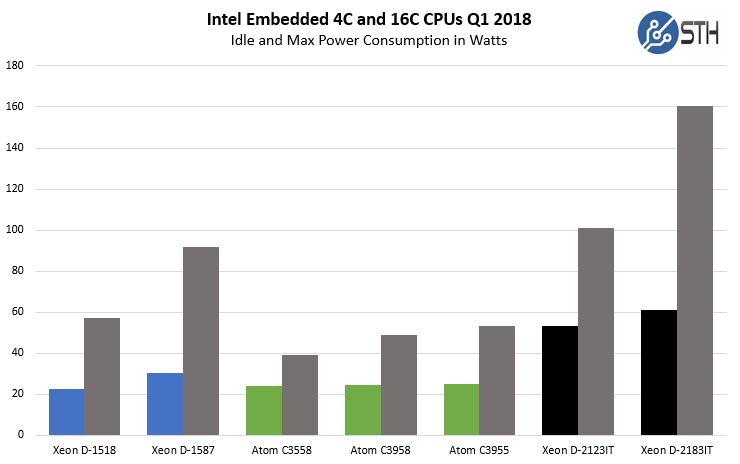Intel Xeon D-2183IT Power Consumption
We wanted to post a few figures from our testing that show the real selling point of the chips, low power.

Idle is around 61W and maximum power consumption hits just over 160W. While you do get more performance from the Intel Xeon D-2183IT as an edge device, you pay for that performance in terms of power consumption.
Note these results were taken using a 208V Schneider Electric / APC PDU at 17.8C and 71% RH. Our testing window shown here had a +/- 0.3C and +/- 2% RH variance.
Intel Xeon D-2183IT Market Positioning
Thes chips are not released in a vacuum instead, they have competition on both the Intel and AMD sides. When you purchase a server and select a CPU, it is important to see the value of a platform versus its competitors.
Intel Xeon D-2183IT v. Intel Xeon
There is a huge separation between the Intel Xeon D-2183IT and the lower power Intel Xeon D-1587 when you look at feature set, performance, and power. If you are not installing the Xeon D-2183IT into a power constrained environment, or the operating costs of tens of watts per machine are not significant, the Intel Xeon D-2183IT is a clear winner.
If you look at Intel Xeon D-2183IT offerings versus single CPU Skylake-SP generation parts, things get strange quickly. The Intel Xeon D-2183IT gains higher levels of integration with the Lewisburg PCH IP onboard, yet sacrifices two DIMM channels per CPU to lower the footprint. Performance wise the new Xeon D is great and the feature set is Skylake for allowing workload live migration.
Intel Xeon D-2183IT v. AMD EPYC
Overall, if you can live with even more power, the AMD EPYC 7000 series platform is less expensive and is more expandable in a single socket. For example, one can get a 24 core AMD EPYC 7401P for about $1100, or $700 less than the Xeon D-2183IT. The EPYC will use more power but give you more PCIe expansion, twice as many memory channels. EPYC 7000 also requires a much larger systems footprint.
The AMD EPYC 3000 series has 16 core SKUs that cost about half of what Intel has with more PCIe lanes and more 10GbE options. Still, months after the AMD EPYC 3000 series launch they are still virtually impossible to find in a channel board in the market. It is hard to compare an available Intel chip to an announced but not in the channel product for AMD.
Final Words
At the end of the day we had a few observations to summarize what we found:
- The Intel Xeon D-2183IT utilizes the Skylake instruction set and the Lewisburg PCH IP to make it a natural extension of your Xeon Scalable data center servers to edge devices.
- This generation is a major upgrade over the previous generation in terms of performance and platform connectivity
- For this performance and platform connectivity, the price is power. This generation has higher power consumption than the Xeon D-1500 series.
- Something is amiss with the AVX-512 on these chips. Their performance is more akin to a dual port FMA Xeon Gold 6100 / Platinum than the other single FMA parts such as Xeon Silver. Perhaps Intel is “sandbagging” specs yet offering an easy inferencing option to its customers with “free” high per-core AVX-512 performance.
Overall, these are great chips for edge deployments, however, we still see value in the Intel Xeon D-1500 series at the edge and likewise do not see them as a direct replacement in the data center for mainstream Intel Xeon Scalable.




Don’t I remember reading that the dual-FMA gold/platinum SKUs drop the AVX clock-rate by half, due to power/thermal issues? Maybe these are single-FMA but maintain full AVX clocks due to fewer cores/lower clocks? Could that explain the FMA workload performance here?
Haven’t tried it myself but,
https://software.intel.com/sites/default/files/managed/9e/bc/64-ia-32-architectures-optimization-manual.pdf
15.20 SERVERS WITH A SINGLE FMA UNIT
“The following example code shows how to detect whether a system has one or two Intel AVX-512 FMA
units. It includes the following: …”
Michael – they do lower clocks, but not by enough to explain what we are seeing, especially on the Gold SKUs.
Kyle Siefring – tried to do a quick gcc compile and it failed. Will try icc later. Things that I know are using AVX-512 (e.g. Linpack) are performing much better than one would expect which is a similar idea to the two loops.
“Still, months after the AMD EPYC 3000 series launch they are still virtually impossible to find in a channel board in the market. ”
AMD, we’re waiting here guys, can’t support the underdog if the product isn’t on shelves
Interesting results re AVX512 – thanks for posting the findings!
Are you able to run a full instruction latency/throughput test?
Agner has some test scripts here: http://www.agner.org/optimize/#testp
If you’re able to run Windows, you can also try AIDA64 (which would be compatible with all the details here: http://users.atw.hu/instlatx64/ )
Also are you able to post the clock rate during AVX512?
According to the information here [ https://twitter.com/InstLatX64/status/963046768849113088 ] the Xeon-D throttles slightly less than the Scalable Xeons, but not by much.
It was initially reported that some Core-X models only had 1x 512b FMA, but this turned out incorrect, so I wouldn’t be too surprised if there’s a reporting error here too.